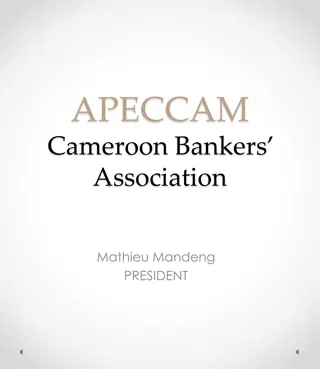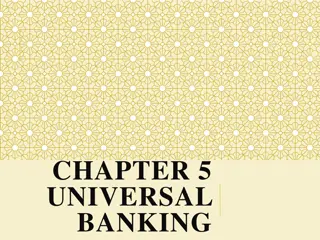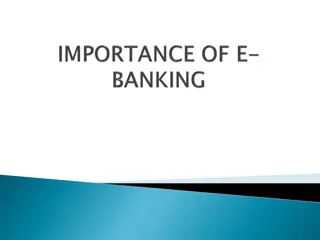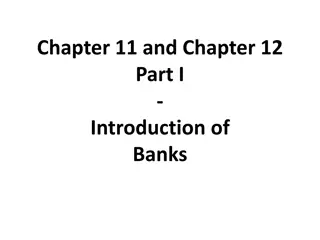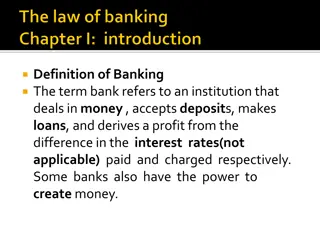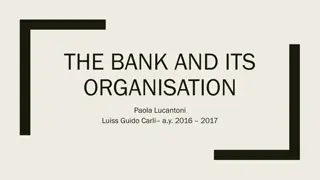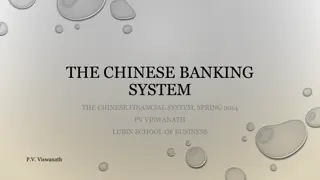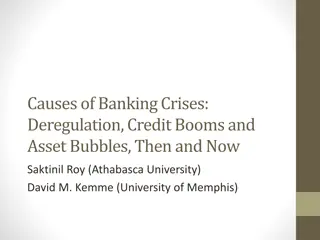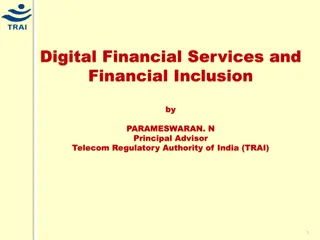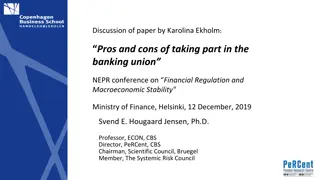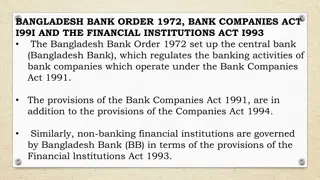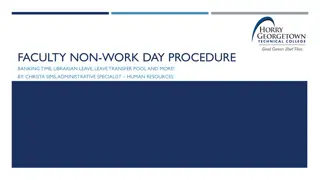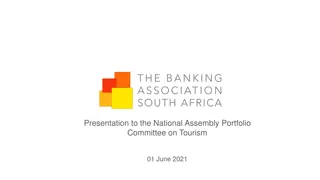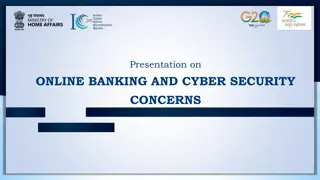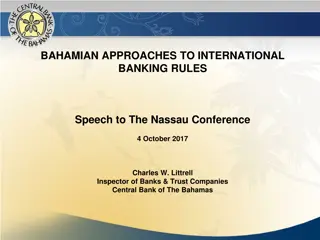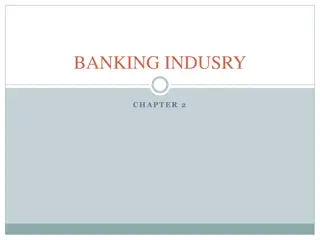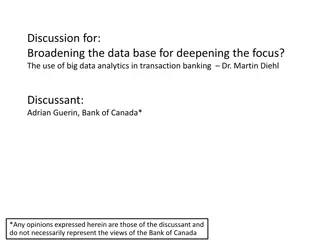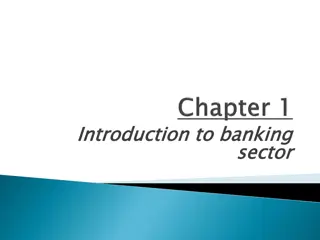Understanding International Banking and Its Impact: Evolution, Features, and Crucial Events
International banking plays a vital role in facilitating global financial transactions, reducing risks for both borrowers and lenders. This article delves into the features of international banking, motives behind banks expanding into new markets, the evolution of international banking institutions, and crucial events such as the 1973 Energy Oil Crisis. The impact of these events on international banking and the global economy is discussed in detail.
Download Presentation

Please find below an Image/Link to download the presentation.
The content on the website is provided AS IS for your information and personal use only. It may not be sold, licensed, or shared on other websites without obtaining consent from the author. Download presentation by click this link. If you encounter any issues during the download, it is possible that the publisher has removed the file from their server.
E N D
Presentation Transcript
International banking (IB) Banks acts as intermediaries This process of intermediation reduces risk of both the borrowers & the lenders Banking transactions crossing national boundaries is called as IB
Features of IB Currency risk Complexity of credit risk Intense competition in the global market Difficulty in dealing with country specific factors Tedious & crucial risk management activities
Why banks started trying new markets Motives for internationalization of banks Migration of enterprise Economies of Scale & Optimum utilization of resources Optimization of cost of capital Diversification of funds Regulatory avoidance Interdependency of Nations
Evolution of IB Formation of BIS: Origin of BIS: it happened to deal with the issue of repatriation of payments imposed on Germany But soon this motive was faded & cooperation came in to being The mission of the Bank for International Settlements (BIS) is to serve central banks in their pursuit of monetary and financial stability, to foster international cooperation in those areas and to act as a bank for central banks.
Crucial events that effected IB 1973 Energy Oil Crisis: The 1973 oil crisis started in October 1973, when the members of Organization of Arab Petroleum Exporting Countries or the OAPEC proclaimed an oil embargo The oil crisis, or "shock", caused many global short- term and long-term economic and political effects. Yom Kippur War
On October 6, 1973, Syria and Egypt, with support of other Arab nations, launched a surprise attack on Israel on the holiest day of the Jewish calendar. Because of which oil prices increased Developed countries were forcing to keep prices of oil low to fund their energy requirements This offended OPEC nations Embrago was formed : partial or complete prohibition of country
1982 international banking debt crisis Debt crisis a country has a current account deficit when its payments abroad are greater than those it receives. A government that finances rather than adjusts to its deficits must borrow from external credit sources and/or decrease its foreign exchange reserves. If the government continues to borrow, it may be burdened with growing foreign debts. Temporary can be solved by taking additional loans Solvency problems in this a debtor regain its credit worthiness only if creditor will reduce interest or principle payments on its debt
Most lending to Latin America in the 1920s occurred through the bond markets Most lending to middle-income LDCs in the 1970s was private bank lending 17 highly indebted states amounting to 194 percent of the banks capital and reserves, and a major debt default would have affected the core of the banking system.
The bakers plan The Baker Plan was launched in October 1985 at the International Monetary Fund/World Bank meeting in Seoul, by James Baker, United States Secretary of the Treasury, as a way to combat the international debt crisis. The Plan was designed to help highly indebted middle-income countries, i.e., those countries that are not incredibly poor but nevertheless owe a large amount of money. Fifteen countries were mentioned, and ten of those were in Central and Latin America.
Brady Plan The only way to address the sovereign debt crisis was to encourage the banks to engage in voluntary debt- reduction schemes.
Asian Financial Crisis: Credit bubbles and fixed currency exchange rates The Asian financial crisis was a period of financial crisis that gripped much of East Asia beginning in July 1997 and raised fears of a worldwide economic meltdown due to financial contagion. The crisis started in Thailand with the financial collapse of the Thai baht after the Thai government was forced to float the baht due to lack of foreign currency to support its fixed exchange rate, cutting its peg to the USD Indonesia, South Korea and Thailand were the countries most affected by the crisis. Hong Kong, Malaysia, Laos and the Philippineswere also hurt by the slump. China, Taiwan, Singapore, Brunei and Vietnam were less affected, although all suffered from a loss of demand and confidence throughout the region.
Asian Financial Crisis Foreign debt-to-GDP ratios rose from 100% to 167% in the four large Association of Southeast Asian Nations (ASEAN) economies in 1993 96, then shot up beyond 180% during the worst of the crisis the International Monetary Fund (IMF) stepped in to initiate a $40 billion program to stabilize the currencies of economies particularly hard hit by the crisis
Subprime crisis of USA Lending to borrowers who are having some history of default Simple initial terms Old trends of always rising housing prices Interest rate rose & it became difficult to repay loans number & volume of default rose As interest rates were very low in USA lot of people from middle income group & OPEC nations came into being, this gave boost to the real estate sector Also many FI like hedge funds & banks lended recklessly & didn t have enough buffer
Euro Zone Crisis Background: Measures taken: Restructuring the Greek Debt Strengthening Italy's policy Strengthening banks ECB bonds purchases
Euro Zone Crisis Background: Measures taken: Direct loans to banks and banking regulation Less austerity, more investment ("growth-friendly austerity" relies on the false argument that public cuts would be compensated for by more spending from consumers and businesses) Increase competitiveness Internal devaluation ( Labour Wages to reduce cost of production) Fiscal devaluation ( Reducing corporate tax burden & while offsetting the loss of government revenues through higher taxes on consumption (VAT) and pollution, i.e. by pursuing an ecological tax reform Address current account imbalances ( as prolonged imbalance creates problems)
Euro Zone Crisis Controversies & causes annual government budget deficit should not exceed 3% of the gross domestic product (GDP) and that the gross government debt to GDP should not exceed 60% of the GD Media Credit rating agencies Speculators No bail-out clause Regulatory reliance on credit ratings Speculation about the break-up of the eurozone
Basel I norms This accord (agreement) represents the set of I nal banking regulations put forth by Basel committee This committee set out rules for minimum capital requirement to reduce risk Minimum Capital to risk weighted assets is 8% Asset classification system was created Assets were classified in to five different classes & each one was given a specific risk weights
Basel II norms This accord represents an integration of Basel I norms with the domestic regulations Basel II accords has more comprehensive measures & minimum standards It provided for convergence in measurement mgmt & supervision of operational risk Building up of capital buffers in good times that can be used in periods of stress Identifying & mitigating risk that arises from newer forms of investment options
Basel II norms Pillar I deals with holding minimum capital requirements Standardized approach: use external credit rating agencies Internal rating based (IRB) approach: use of internal risk assessment systems Advanced IRB: used advanced techniques
Basel II norms Pillar II deals with supervisory review process to be followed by the central bank There are three main type of risks credit, market, operational Credit Market Operational Principles of pillar II includes banks should develop process for assessing overall capital adequacy, Supervisors should review & evaluate CAR , its assessment system, encourage banks to operate above CAR, prevent capital from falling below the minimum levels required to support the assessed risk
Basel II norms Pillar III deals with need for market discipline & disclosure required there under
Basel III Norms Basel III (or the Third Basel Accord) is a global, voluntary regulatory standard on bank capital adequacy, stress testing and market liquidity risk Basel III was supposed to strengthen bank capital requirements by increasing bank liquidity and decreasing bank leverage.
NRE, NRO, FCNR Repatriation NRO account has restricted repatriability i.e permitted remittance allowed from NRO is up to USD 1 million net of applicable taxes in a financial year after giving undertaking along with a certificate from a chartered accountant. NRE account is freely repatriable (Principal and interest earned) Tax Treatment interest earned in NRO account and credit balances are subject to respective income tax bracket and are also subject to applicable wealth and gift tax NRE account is Tax free (no Income tax, wealth tax and gift tax) in India
NRE, NRO, FCNR Deposit of Rupee funds generated in India NRI/PIO is earning income originating in India (such as salary, rent, dividends etc.) he/she is only allowed to deposit it in NRO account. Deposit of such earnings is not permitted in NRE account. Joint Holding NRO account can be held with NRI as well as resident Indian (close relative) as defined under Section 6 of the Companies Act 1956. NRE account can be jointly held with another NRI but not with resident Indian.
Foreign Currency Non Resident (B) Account [ FCNR(B)] Are governed by the provisions of [Foreign Exchange Management (Deposit) Regulations, 2000.] A Foreign Currency Non Resident (B) Account FCNR accountcan be opened and maintained by a citizen of India or a person of Indian origin residing outside India as also Overseas Corporate Bodies (OCBs). The accounts are convertible / repatriableand are maintained in the form of savings, current and recurring or fixed deposit accounts.
Importance of IB in India (Discussion)
Role of central banks in IB and business Risk Assessment Monetary policy Revamping prudential regulations Strengthening the provisions of banking services





